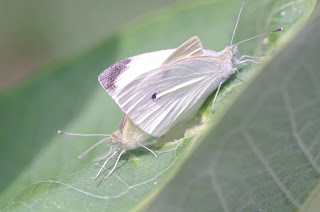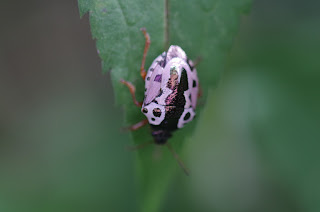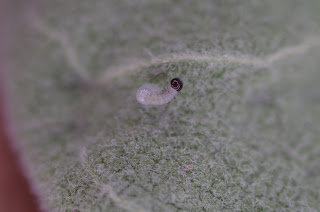From the beginning...
Well, this is how it begins, isn't it? (Cabbage white butterflies)
Then there's the laying of eggs. (Snowberry clearwing hummingbird moth–and that is a much longer name than anything should have to bear).
Here is one of the eggs she laid.
Next, there's hatching from the egg. Monarch caterpillar
And of course, everything needs to eat. (Robber fly)
(Or be eaten)
So many things to eat for insects... (Such a variety of bees today)
(The predator is an assassin bug. I don't know what the prey is)
Some that don't want to be eaten think there may be safety in numbers. (Aphids?)
And sometimes they are looked after. (Ants tend to aphids to get honeydew from them).
They grow... (hopper nymph)
(Stink bug nymph)
They metamorphise (Well, not all insects experience complete metamorphosis–those that begin life as larvae do).
And as adults, they work (Sweat bee. And I don't know if sweat bees have worker bees, or if they even live socially. But you get the idea).
No one wants to think about what happens after that.
And there you have it–life as a bug. More or less.
If you've been reading this blog for years, you may remember how in other summers I would find a million bugs in a day and post about that many pictures. That hasn't happened this summer, because I just haven't been finding the bugs. A good day this summer has brought me close to 200 pictures. Well, today I took 550+. I found a lot of bugs. Brace yourself for a billion bug pictures...
First, Backyard Bug of the Day:
Siretrus anchorago–a species of stinkbug that unfortunately feeds on caterpillars. I found one of the two I saw today on milkweed, and if I had known that it was a caterpillar eater I don't know that I would have chosen it as Backyard Bug of the Day! But it is not for me to choose sides between bugs. It is very pretty, too, slightly pink, and the ones I saw today were extremely iridescent.
It's hard to tell because they are blurred, but it's wings are flapping here, and you can see what its body looks like under the wings and wing covers.
Before I get to the billion pictures of other bugs, here's more of the hatching monarch caterpillar:
You can tell that the egg will be hatching soon because it gets dark at the top. That is the tiny caterpillar's dark head.
You can just see its legs here.
Once it's free, the first thing it does it turn around...
... and eat the egg.
Three caterpillars hatched last night.
By morning this one had eaten a few holes in the leaf and made some frass. I guess it doesn't take long to pass through such a tiny digestive system.
Now, for a billion other bugs (Some of which were in the montage above):
Better shots of the hummingbird moth
A couple of monarch caterpillars in their late-stage gorging mode
Fly
These triangular moths (not their name, just my description of them) have a tendency to be scared up by me walking by, and then they land a few feet in front of me. Then when I try to take a picture, they fly another few feet away... and this can repeat itself for as long as I want to put up with it (usually only one photo attempt). Today I managed to get pictures of two of them.
Robber fly. Impressive ovipostior. It appeared that she was trying to lay eggs, but that's an iron trellis, not a tree branch.
Immature cricket
Another cricket, different species
Stink bug, blending in pretty well
Flower flies
There's two aphids here...
Lady beetle
Lace bug
Leaf footed bug nymph
Like jewels
An empty insect egg
Wasp
Some day I will get a good picture of a tumbling flower beetle...
... but today is not that day.
I used to get asked a lot, "How do you find all these bugs?" The answer is usually that I look for them. It sounds flip, but that really is the reason I find them, while someone else walking around outside would miss most of them. And sometimes, all you get is this little hint, of some antennae peeking from behind a leaf. Then you look underneath and find...
... a tree cricket.
This is a really big bug, about ten feet up the trunk of a tree, that had about 6 feet of briars between me and the tree. I had to use my telephoto lens to get this picture. I can't really tell what it is.
Eight spotted forester moth
Arachnid Appreciation:
.
.
.
.
.
.
.
.
.
.
.
.
Flower crab spider
Jumping spider


































































No comments:
Post a Comment